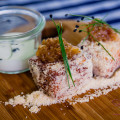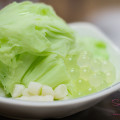 For nine years, since the first year we started dating, Shake and I spent Thanksgiving with his family in Hilo. A few years ago, we had to change our annual visit to New Year’s instead, because of his work schedule. But no matter the time of year we visited, for nearly every one of those dozen years, we had “lumpies.”
For nine years, since the first year we started dating, Shake and I spent Thanksgiving with his family in Hilo. A few years ago, we had to change our annual visit to New Year’s instead, because of his work schedule. But no matter the time of year we visited, for nearly every one of those dozen years, we had “lumpies.”
On my first Thanksgiving visit to Hilo, Shake’s mother taught me how to make lumpia (the Filipino version of spring rolls). Shake says that for some reason, since he was a kid, they referred to lumpia as “lumpies.” I thought it was cute.
Last October, Shake’s mom passed away.
So instead of spending New Year’s with his mom (whose birthday fell on New Year’s Eve), we returned to the tradition of going to my parents’ house. Shake wanted to do something to remember his mom by, and asked if we could make one of her recipes to share with the family. We settled on lumpia.
Unfortunately, Shake came down with an incredibly violent bout of the stomach flu the night before New Year’s Eve. (The last third of 2012 wasn’t exactly kind to us. We were pretty happy to see it go.) We ended up eating none of the food we’d bought to make that night, and we didn’t even break out the bubbly. With him out of commission, lumpy duty fell entirely to me.
I had no illusions that the mixing of the pork filling was ever going to be anything but my responsibility (as it had always been my mother-in-law’s job), but Shake always lent a hand in rolling the lumpia when we made them at her house, and was planning to do so for this special batch. Stupid germs, taking away my sous chef. On the other hand, Shake’s mom always said I was faster and better at lumpia assembly. (I will not deny that statements like these may have prompted the actual use of the phrase, “Nyah, nyah! Your mom likes mine better!” I know, I’m horribly competitive—it’s awful.) And in truth, it didn’t take me long to roll up the whole batch on my own. It was actually rather satisfying in that repetitive task way, and while I worked, I thought about how sweet Shake’s mom had always been to me and how happy she was to finally “get a daughter” (having only unmarried sons until the point Shake and I got hitched).
I’m so glad that Shake’s mom taught me how to make these, and shared this part of her family with me. Shake says that he thinks she must have gotten the recipe originally from one of her co-workers and over the years took out ingredients she didn’t like and put in what she did.
Mama Shake’s Lumpies
There are no measurements, so it’s all a matter of trying to remember, “Is that how it tasted when Mom made it?” But isn’t that what a family recipe is all about? I added a few notes to help you along. Shake’s mom always made skinny lumpia, not a whole lot thicker than your finger; it helped them cook faster and—more importantly to her because she hated rare meat—thoroughly.
- Ground pork (1.5 to 2 lbs. will make approximately two dozen to 30 lumpia, which are then cut in half)
- Green onion, chopped fine (3 or 4 stalks)
- Garlic, chopped fine* (1-2 cloves; depends how garlic-y you like your food)
- Carrots, chopped fine* (1 skinny or ½ a fat one)
- Water chestnuts, chopped fine (one can is good for the above amount of pork)
- Salt and pepper
- Lumpia wrappers (one package; you won’t need all of it)
- Vegetable oil
- Flour/egg paste (1 tablespoon flour mixed with 1 egg white)
*I honestly can’t recall if my mother-in-law actually minced these ingredients, but it’s what’s written in her notebook. I prefer to use a garlic press on the garlic and use a box grater to shred the carrots.
Mix green onion, garlic, carrots and water chestnuts with the pork and add salt and pepper.
Put mixture in lumpia wrapper and roll.
If you’re lacking a helpful mother-in-law to show you how to do this, here’s how:
Separate the lumpia wrapper sheets from each other first. They stick to each other like crazy, but they’re delicate, so be careful. Once separated, they won’t stick to each other again, so stack them on a plate.
Spread the filling in a thin line diagonally across a wrapper. Keep the filling to about the size of your finger (maybe your thumb, if you have skinny fingers like me). Leave a couple inches bare on either end of the filling line.
Fold one half of the wrapper over the filling and roll tightly around the filling until only a third of the wrapper is left.
Paint along the outer edges of the remaining exposed wrapper with the egg paste. Fold the ends in and continue rolling. This tucks the ends in securely, and the egg paste seals it. (If you’re having trouble envisioning this, don’t worry—the wrapper package has a nice little diagram.)
Repeat until you run out of filling or wrappers. You can freeze the lumpia like this for several weeks, or even a couple months—just try not to let ice crystals form on them. Defrost before frying.
Cut in half. As long as you’ve rolled tightly, the filling shouldn’t fall out, but the hot oil does seep in through the cut end to help cook the inside. Plus, they’re way easier to cook and eat when they’re a more manageable 3 to 4 inches, instead of 6 to 8.
Deep fry in hot oil. Be careful the oil isn’t TOO hot, or else your wrappers will begin to burn before the pork inside is cooked. They should be a nice golden brown color. Drain on a paper towel or baking rack. Eat while they’re still hot!
Make an oil and vinegar sauce for dipping. This is what it says in her recipe notebook, but I really can’t help you on this one. I am not a dipping sauce fan, so I never actually tasted this. A search online for lumpia dipping sauces turns up many recipes, most of them extremely simple, but none that are strictly oil and vinegar. Find one you like, or use a commercial sauce you like. Lumpia are traditionally dipped in a sauce comprised with that holy duo of Filipino flavors, vinegar and garlic.
My family enjoyed the tray of lumpia—they were inhaled in rapid fashion—and my parents and sister-in-law were touched by Shake wanting to share a family dish from his mom with them. (Who knows what my brother thought…I never can tell…he did really like the lumpia, though.) My guess is that we will incorporate this into our family tradition of New Year’s dishes, probably some of the batch on the Eve—in honor of Mom’s birthday—and the rest with my family on New Year’s Day, along with our ozoni.
Do you have a family food tradition that has special meaning for you?
















Malia
March 15, 2013 10:00 pmWhat a special tradition to share – I love this! And it makes me crave lumpia, I mean lumpies! Thanks for sharing the recipe!
When my grandma passed away I kept one box of all her cookbooks and handwritten recipe cards. I ended up scanning them to keep them handy, and this post makes me want to go dig through them to find something to make… It’s been awhile since I’ve looked through them. 🙂
sugar
March 16, 2013 2:23 pmThanks, Malia! It’s kind of soothing to make them on your own, but it’s fun to make a batch with a helper or two.